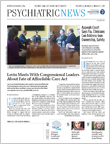Some Patients With Schizophrenia Experience OCD Symptoms
More than 25 percent of patients with schizophrenia experiences comorbid symptoms of obsessive-compulsive disorder (OCD), according to a study published in Psychiatry Research.
A total of 181 adults with schizophrenia were evaluated using the Yale-Brown Obsessive-Compulsive Scale, the Yale-Brown Obsessive-Compulsive Symptom Checklist, and the Positive and Negative Syndrome Scale.
The analysis showed that 51 patients (28.2 percent) met the criteria for current OCD, and 71 (39.2 percent) reported having experienced at least one obsession or compulsion for one month or more. The most common obsessions reported by patients were those of contamination (25.4 percent) and a need for symmetry and exactness (11.6 percent); the most common compulsions were cleaning/washing (27.1 percent) and checking (24.3 percent).
When the authors compared patients with current OCD with those without, they found patients with current OCD were more likely to have experienced the onset of schizophrenia at a younger age. Patients with schizophrenia and OCD were also more likely to have comorbid depression and report suicidal ideation.
Additional analysis revealed that patients with schizophrenia who were in remission but met the criteria for OCD had higher levels of disability in the domains of communication and understanding than those without OCD; those in clinical remission with OCD also had higher a prevalence of depression.
Link Found Between Schizophrenia, Urinary Incontinence
A study published in Psychiatry Research has found an association between schizophrenia and increased risk for urinary incontinence (UI), particularly among males.
While several reports have shown UI to be a potential side effect of antipsychotic use, few studies have investigated if schizophrenia alone confers such risk.
Researchers from the China Medical University and Asia University used health insurance claims data from 2005 to 2011 to compare the risk of UI in patients with and without schizophrenia.
Patients with schizophrenia had a 1.78-fold higher risk of UI than those without schizophrenia after adjusting for comorbidities and antipsychotics and anticholinergic agents. The risk of UI was even greater in patients with schizophrenia aged 20 to 54 (OR=3.00). Men with schizophrenia were also significantly more likely to experience UI (OR=3.69) than their female counterparts (OR=1.12).
“This is the first study to report the association between schizophrenia and risk of UI. … Early detection and intervention of UI might improve the quality of life among patients with schizophrenia,” the authors concluded.
Collaborative Care May Benefit Older Adults With Mild Depression
Collaborative care may lead to improvements in older adults with subthreshold depression, according to a study published February 21 in JAMA. Although more research is needed to understand the long-term effects of the therapy, the findings point to a brief and relatively inexpensive method that might be able to reduce the likelihood that patients with mild depression develop more severe symptoms.
Researchers from the University of York in the United Kingdom randomly assigned 705 adults aged 65 years or older with subthreshold depression (according to DSM-IV) to receive either usual care from their primary care physician or a collaborative care intervention in addition to their usual primary care.
Of the 705 patients who started the trial, 519 remained at the 12-month follow-up. The PHQ-9 score was 7.8 in both groups at baseline and declined to 5.4 in the collaborative care group and 6.7 in the usual care group at four months (mean difference, −1.31)—a difference that remained at 12-month follow-up.
Additional analysis revealed that while the progression to threshold-level depression (defined in this trial as a PHQ-9 score ≥ 10) was not different between the two groups at four months (17.2 percent versus 23.5 percent), it was significantly less frequent in the collaborative care group compared with usual care at 12 months (15.7 percent versus 27.8 percent). Patients in the collaborative care intervention also demonstrated improvements in anxiety, functional status, and more compared with those in the usual care group.
Habitual E-Cigarette Use Linked to Physiological Effects
Habitual e-cigarette use may be associated with increased cardiovascular risk, according to a study published February 1 in JAMA Cardiology.
Holly Middlekauff, M.D., of the University of California, Los Angeles and colleagues compared oxidative stress and cardiac sympathetic activity in habitual e-cigarette users (n=16) and those who did not use e-cigarettes or smoke cigarettes (n=23).
They found that people who habitually used e-cigarettes were more likely to experience a shift in cardiac autonomic balance toward sympathetic predominance and increased oxidative stress—both associated with increased cardiovascular risk—than nonusers of e-cigarettes.
“On the basis of these studies, we can conclude that habitual e-cigarette use is associated with physiologic effects. Nonetheless, we cannot confirm causality on the basis of this single, small study; further research into the potential adverse cardiovascular health effects of e-cigarettes is warranted,” the authors wrote. ■




